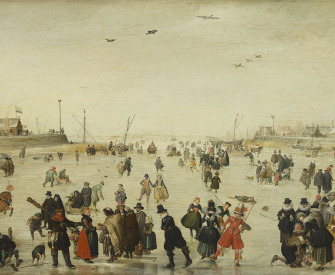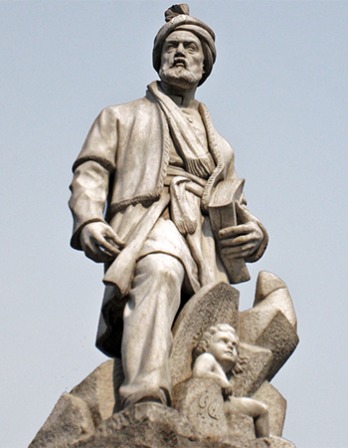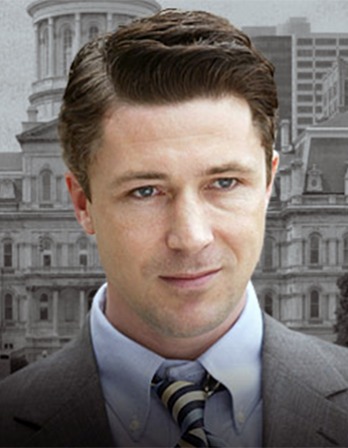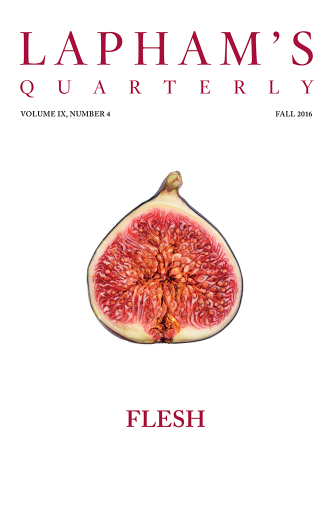Any city, however small, is in fact divided into two, one the city of the poor, the other of the rich; these are at war with one another.
—Plato, 378 BCCity Light
When it comes to the medieval cathedral and mosque, the modern skyscraper and the slum, world history is city history.
By Lewis H. Lapham

Piazza San Marco, by Canaletto, late 1720s. The Metropolitan Museum of Art, purchase, Mrs. Charles Wrightsman gift, 1988.
The city, as we imagine it, the soft city of illusion, myth, aspiration, nightmare, is as real, maybe more real, than the hard city one can locate on maps, in statistics, in monographs on urban sociology and demography and architecture.
—Jonathan Raban
The Census Bureau counts 232,581,397 Americans, 82.6 percent of the population, living in the nation’s cities, but if our moralists and intelligence services are to be believed, they do so at no small risk to the safety of their persons and the security of their souls. This issue of Lapham’s Quarterly addresses the obvious contradiction. If the city is a sewer of vice and a slough of despond, why do so many people choose to live there? On what toxic landfill does the city stand as the embodiment of its ennobling cognate, civilization? The questions bear asking because the future is urban, and the answers are what the new millennium is likely to make of its art and religion as well as of its government and working arrangement with nature.
I borrow the supposition from Oswald Spengler’s reading of world history as city history. He located in the city “the determinative form” of a culture or the spirit of an age (“Egypt is Thebes, the orbis terrarum is Rome, Islam is Baghdad, France is Paris”), and in 1917 he foresaw, “long after the year 2000,” the appearance of “cities laid out for ten to twenty million inhabitants,” lumpen and inorganic agglomerations with “notions of traffic and communications that we should regard as fantastic to the point of madness.” Match the contemporary scale of municipal infrastructure in Asia, Africa, and Latin America with the demographic estimates—nearly half the world’s population, at least 3.3 billion people, already live in cities—and we have before us what Spengler regarded, not cheerfully, as an “artificial, mathematical, utterly land-alien product of pure intellectual satisfaction.” The description accords with satellite photographs of Shanghai or Lagos, the drawings of Frank Lloyd Wright, the designs of Blade Runner and Grand Theft Auto.
But if we can guess at the form of the city looming on the horizon of the twenty-first century, in whose name is it being built, and what gods does it serve? The way in which a city is seen or approached, by whom and from what vantage point, invests it with the moral and emotional roofing that
Warren Breckman looks to find, as did Spengler, in the Roman forum and the Greek agora, the medieval cathedral and mosque, the modern skyscraper and slum. So too with every other text, illustration, and map in the following pages. Whether it is the light that Canaletto floats on the surface of a Venetian canal, Charles Baudelaire delighting in the spectacle of “fine carriages and proud horses...the sinuous gait of women,” or Stefan Zweig taking note of “the delicate and musical transitions” in the stonework of empire, the city is the reflection in the eye of the beholder. An act of the imagination, says Breckman, the seen as intimation—in brick or paint or word or marble—of the unseen. The earliest cities mirrored what was thought to be the design of the cosmos, the builders of temples and ziggurats beholden to blueprints discovered in the movements of the stars and the changing of the seasons. Pericles conceived of ancient Athens as the expression of man’s humanity to man, the democratic freedoms awakened in the hearts of its citizens the reason “to fall in love with her.” Louis XIV intended the construction of Versailles and his refurbishing of seventeenth-century Paris to “mark the greatness of princes.” Revisiting New York City in 1904 after an absence of twenty years, Henry James was appalled by “the terrible town,” deafened by “the huge American rattle of gold.” Moved to a feeling of pity for the “caged and dishonored condition” of Trinity Church dwarfed by “steel-souled” office buildings, James portrayed the city as the realized ideal of a society abandoned, as was Sodom, to the worship of Mammon. The annihilating spirit of finance capitalism achieving its most perfect expression not only as architecture but also as a social order and a style of feeling—an “inconceivably bourgeois scheme of composition” with “new landmarks crushing the old quite as violent children stamp on snails and caterpillars.”
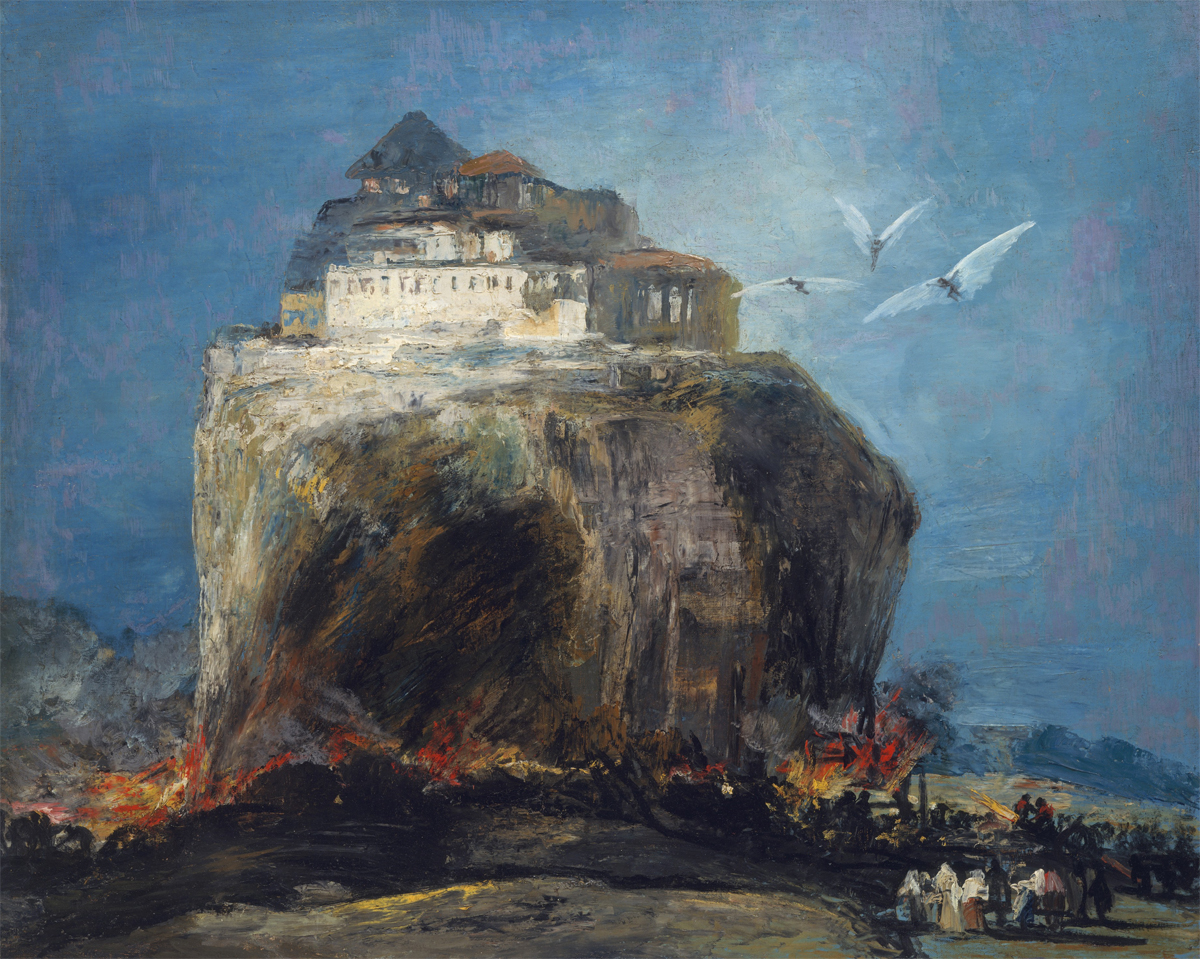
A City on a Rock, in the style of Goya, 19th century. The Metropolitan Museum of Art, H. O. Havemeyer Collection, Bequest of Mrs. H. O. Havemeyer, 1929.
The density of the immigrant swarm on the Lower East Side at the turn of the century, more than 2,600 people per acre, equaled in its misery but exceeded the crowding then prevalent in the slums of Bombay. In the years since, most of the alien labor has been sanitized or outsourced, but the comforts of the city’s rich still depend on the abundance of its poor, the municipal wealth and well-being as unevenly distributed as in the good old days of the Gilded Age. When seen at a height or a distance, from across the Hudson River or from the roof of Rockefeller Center, Manhattan meets the definitions of the sublime. At ground level Manhattan is a stockyard, the narrow streets littered with debris and laid out in the manner of cattle chutes, the tenements and storefronts uniformly fitted to fit the framework of a factory or a warehouse. The modus vivendi under the boot of the modus operandi. The commercial imperative comes with no apology. Like most other American cities, New York is a product of the nineteenth-century Industrial Revolution, built on a standardized grid, conceived neither as a thing of beauty nor as an image of the cosmos, much less as an expression of man’s humanity to man, but as a shopping mall in which to perform the heroic feats of acquisition and consumption.
Baudelaire in nineteenth-century Paris marveled at the “turmoil of human freedom” as he watched “the river of life” flow past him in all its “splendor and majesty.” New York doesn’t afford either the luxury or the pleasure of such a marvel. No grand boulevards or baroque sculpture, no vistas with trees and fountains, no straying in midtown from the herd of hired hands anxious to keep to their schedule of milking the golden calf. The dismal sight calls to mind the first words in English that the International Harvester Company taught its Polish factory workers in 1912: “I hear the whistle. I must hurry.”
The perception of the city as the citadel of Satan arrived on the shores of Massachusetts Bay with the seventeenth-century Puritans, who imagined themselves making haste from the Gomorrah that was Jacobean London, “cruelty and blood” in the streets, nothing anywhere in sight except “murders, slaughters, incest, adultery, whoredom, drunkenness, oppression, and pride.” To their new Jerusalem in a wilderness they brought the notion that God’s grace is rural, best suited to planting in close association with the flowers, the apple orchards, the alewives, and the birds. John Winthrop’s envisioning of the City on a Hill is a promise of a safe return to Eden, more along the lines of a suburban real-estate development than an urban renewal project, nearer in spirit to the Shire in J.R.R. Tolkien’s The Lord of the Rings than to the dream of an architectural paradise regained cobbled together with the buildings of Christopher Wren.
The pastoral romance has been with us for almost four hundred years, the dominant narrative in much of the country’s literature and most of its political campaigning. On the charts marking the distribution of the country’s spiritual resources, the heavy deposits of the good, the true, and the beautiful are never far from a grain silo or a village green. Virtue doesn’t keep a house in town; it’s out there beyond the beltway, across the river and into the trees, going west with Horace Greeley or catching frogs in Walden Pond, on the road with Johnny Appleseed or Jack Kerouac, upstate and down home. The abiding sentiment is bipartisan, embraced by politicians on the liberal left and the conservative right, by John Adams, Thomas Jefferson, Jimmy Carter, Abraham Lincoln, and Teddy Roosevelt, by the members of both the Sierra Club and the National Rifle Association. The essayists and novelists in the service of the greater American good, among them
Theodore Dreiser and Mike Davis look to the city as if to a dictionary of fear and loathing. The makers of Hollywood film noir populate the urban killing-ground with predators of every known species and description (painted whores and heartless bankers, shameless journalists, vile landlords, crooked politicians, dangerous black people) who roam the streets as do the beasts of prey drifting across the Serengeti Plain.
Fortunately, there’s also the other side of the coin and the story, and if my own view of the city is at odds with the threatening camera angles, it’s not only a matter of optics but also the result of my early reading of nineteenth-century French and English novels in preference to the sermons of Jonathan Edwards. Born and raised in the province of California, I imagined New York as did the young David Copperfield seeing London from a distance as “an amazing place...I vaguely made it out in my own mind to be fuller of wonders and wickedness than all the cities of the earth.” The rumors tended to be confirmed in The New Yorker magazine by Dorothy Parker, A.J. Liebling, John O’Hara, Alexander Woollcott, and E.B. White. They didn’t shy away from the notion of a gladiatorial arena (neither did Honoré de Balzac or Charles Dickens), but they made space on the bloody sand for the artist, the actor, and the musician, as well as for the stockbroker and the merchant. For the free play of the mind as well as for the indentured service to a market.
By the time I read White’s essay “Here Is New York” I was a city-side reporter for the New York Herald Tribune and beginning to suspect what he meant by the city’s capacity to bestow “queer prizes,” among them “the gift of loneliness and the gift of privacy” that place the inhabitant in “the happy position of being able to choose his spectacle and so conserve his soul.” The meaning of the remark came clear on a cloudy afternoon in Central Park when I came across two men seated on a bench, each with a fanciful parrot resting on his shoulder, engaged in intense discussion accompanied by decisive gestures and rapid changes of expression. The parrots were identical; the two men were as unlike one another as a ferret and a panda—on the near end of the bench a small and heavily damaged white man in a threadbare raincoat, early seventies, not many teeth, sunken chest, furtive demeanor; at the far end of the bench a handsome and handsomely tailored black man, gold jewelry, stylish hat and brocade vest, broad-gauged grin, majestic presence.
In answer to my questions, I was told that the parrots were the only two of their particular species ever to have made it north of the Panama Canal, that the two men had met by accident while out walking their birds on 125th Street, that each had come to regard the other as the only man in America with whom it was possible to hold an important conversation. E.B. White had attributed New York’s “poetical deportment” to the fortunate meeting of minds among people come to town in search of “some greater or lesser grail.” Here then, seated with parrots on a bench in Central Park, was the transfer of energy that is the source of the city light. “The metropolis,” as per the observation of Ezra Pound, as “that which accepts all gifts and all heights of excellence, usually the excellence that is tabu in its own village.” What suburban opinion deplores as abomination (traffic, crime, noise, confiscatory taxes, extortionate rents), the urban disposition regards as the price of escape from the tyranny of the small-town majority, as the cost of the blank canvas (i.e., the gifts of loneliness and privacy) on which to discover the portrait of oneself.
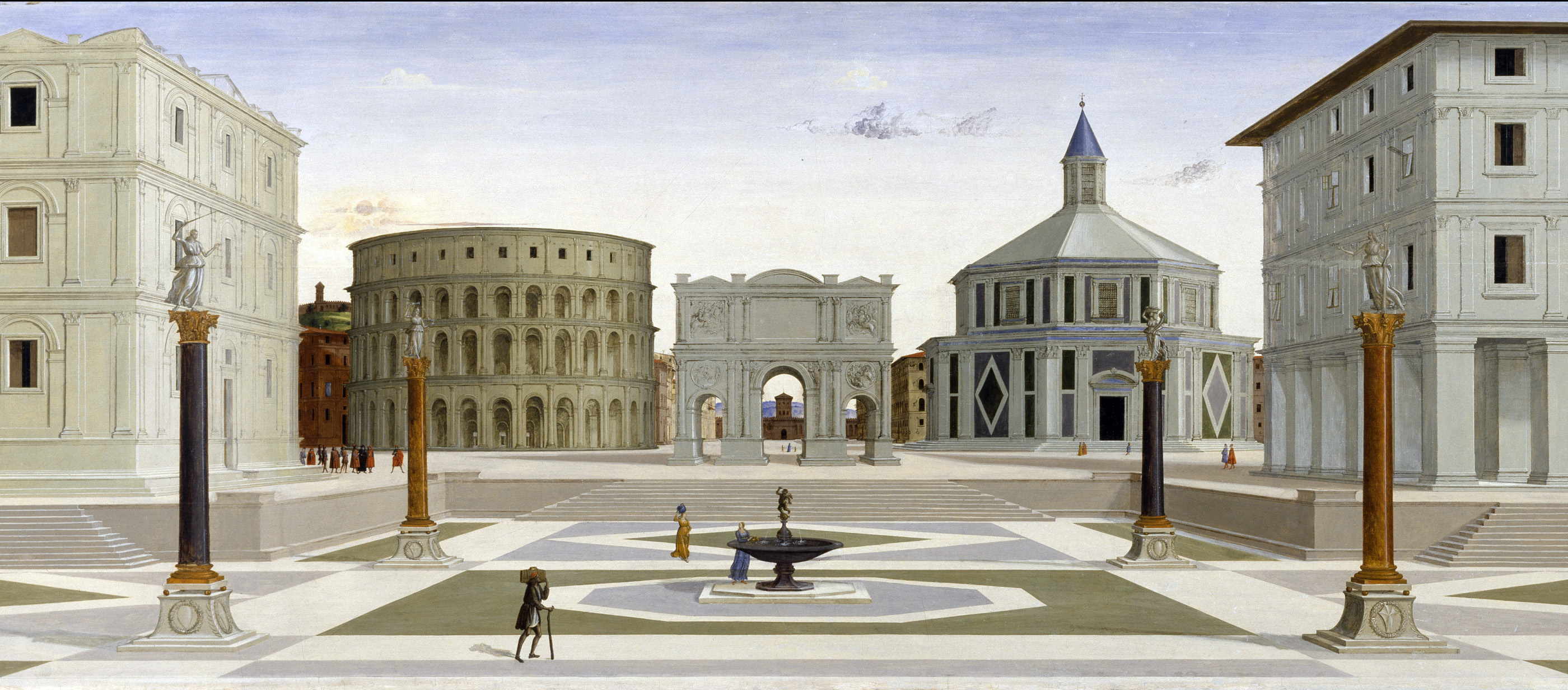
The Ideal City, attributed to Fra Carnevale, c. 1482. Walters Art Museum, Baltimore.
If the city is as one wishes to see it, an illusion maybe more real than a drainpipe or an arrest warrant, I drew my own postcard of New York during the 1960s in the drawing room of George Plimpton’s apartment on East Seventy-second Street. Then the editor of The Paris Review, a literary journal that published the leading writers of the moment, Plimpton’s generously metropolitan spirit accounted for his insatiable curiosity and irreducible enthusiasm. He was in the habit of throwing parties, to which the guests didn’t come with the thought of reading their names in the papers; they came, as did the parrots to Central Park, to meet with a like-minded passion, with the hope of finding somebody else in the room similarly bent on a career in the theater or inclined in the direction of a brothel, possibly obsessed with a reciprocal fondness for Chinese poetry or German leather. Usually the room was filled with cigarette smoke, the conversations apt to become disruptive, rhapsodic, insulting, unintelligibly arcane, intelligibly erotic. Bearing in mind that it was George who was buying the gin, nobody took offense. They shared the sentiment once voiced by Oliver Wendell Holmes: “Fresh air and innocence are good if you don’t take too much of them—but I always remember that most of the achievements and pleasures of life are in bad air.”
If it is in the nature of great cities to amass brutal concentrations of poverty and crime as well as of hypocrisy and wealth, so also it is in the nature of the inhabitants, accustomed to the breathing of bad air, to vote against the motions for divine vengeance put forward by the biblical prophets in the desert who would let loose upon the earth the redeeming flood and the purifying fire. The city stands willing to sell, at a steep discount and on an hour’s notice, last year’s priceless truth or next week’s incomparable celebrity, at the same time offering to buy, at fair market price, new lyrics for an old song. Where else but in a city does so much latent violence depart in peace? Where else is it as possible to publicly demand a revolution while enjoying the protection of the police? It is the country, not the city, that supplies the tabloids with tales of righteous massacre—thirty-two students slaughtered in Virginia, eight fellow workers murdered in Connecticut, three college biology professors executed in Alabama. The city instills the habit of forbearance, teaches the lessons of civility, encourages the practice of democracy, testifies to the truth of the proposition succinctly put by Publius Clodius Paetus Thrasea, a Roman senator remarking on the conduct and deportment of the Emperor Nero: “He who hates vice, hates humanity.”
No city should be too large for a man to walk out of in a morning.
—Cyril Connolly, 1944Such at least was my view of Manhattan as I found it in the 1950s and 1960s, the establishing shot accompanied by Paul Desmond on alto saxophone, Charles Mingus on bass. The impression was as much a consequence of dumb luck as a question of optics. I never was set upon by thieves, struck by falling masonry, or mobbed by anything other than a gang of words. I couldn’t dispute the industrial-strength dehumanization of the terrible town that James had noticed in 1904, but I could counter the indictment with the thought that the cultural enterprise of the fourteenth-century Italian Renaissance was summoned into existence by the loud rattle of gold otherwise known as the Medici Bank. The flowering of such a thing as a civilization springs from the same soil that grows the exotic blooms of pride, lust, wrath, envy, and greed.
The paradox has no standing in the current climate of gentrified opinion. I’ve heard it said, by young historians and aging taxi drivers, that in the years between 1920 and 1980, Manhattan provided accommodation for both Mammon and Apollo, the center of the world in the century denominated as America’s own. I’m not inclined to doubt the claim, but I suspect that it’s no longer valid. During the 1980s the synonym for America’s wealth and power moved south to Washington, DC, which, like Los Angeles, possesses both the character and sensibility of an expensive suburb. As was true of their Puritan forbears in the New England wilderness, the nation’s ruling and explaining classes regard the urban temperament as the port of entry for all things foreign and obnoxious. Over the last thirty years the government bureaucracies have come to employ more people than lived in seventeenth-century England, planting the bulk of their intelligence operations in the Virginia countryside with the fruit trees and the birds; our larger corporations retreat to pastoral compounds bearing a postmodern resemblance to the manors in medieval France; artists and writers of note drift away to villages in Connecticut. The projectors of the urban future meanwhile define the Internet as the civilizing agent that replaces the need for the New York Stock Exchange and the Broadway theater, and the great, good American place, under the protection of the Department of Homeland Security and safe behind a gated perimeter, comes to be imagined, as was John Winthrop’s City on a Hill, as a refuge from the storm and wonder of the world rather than as the progenitor of its energy and the locus of its desire.
